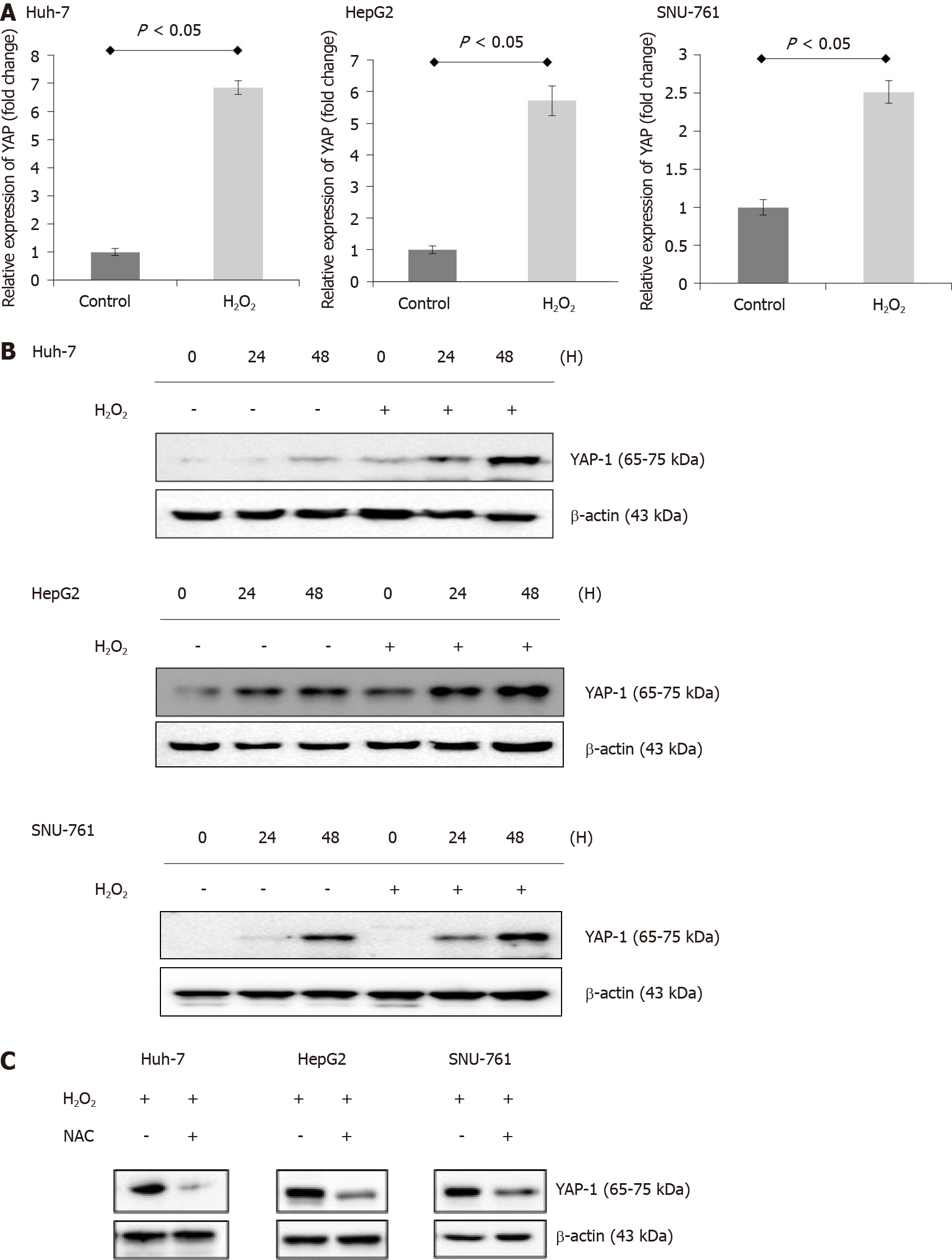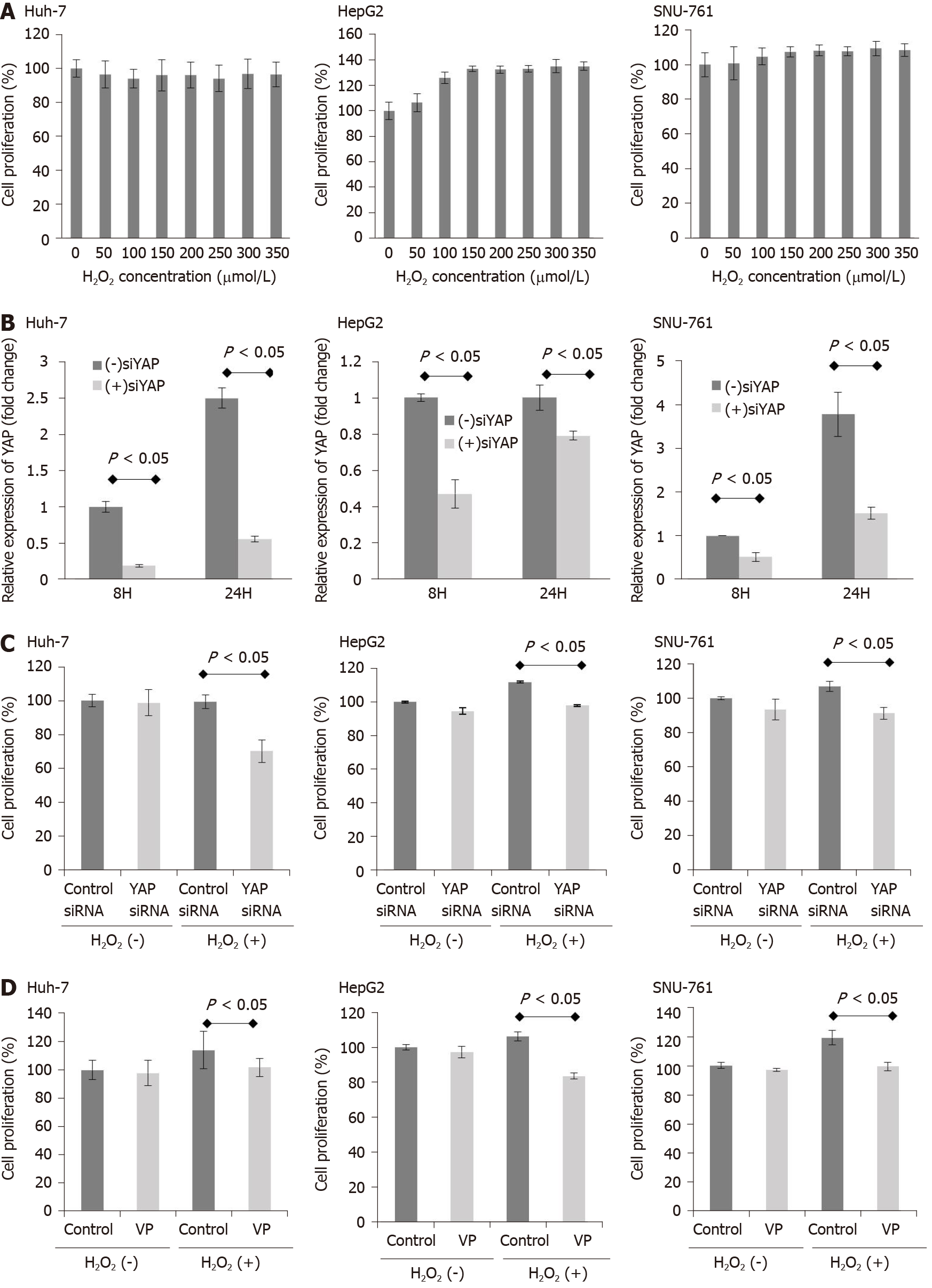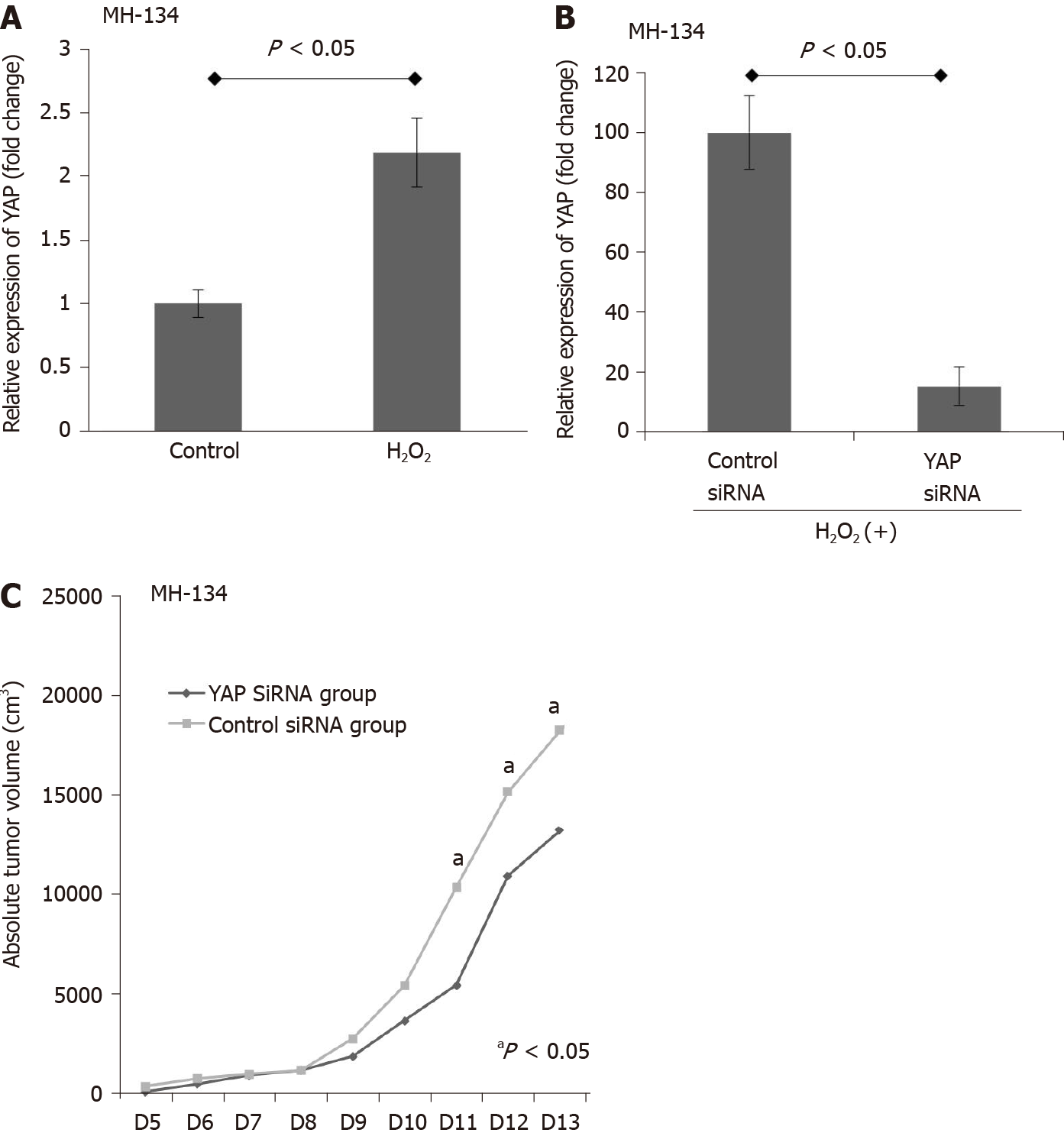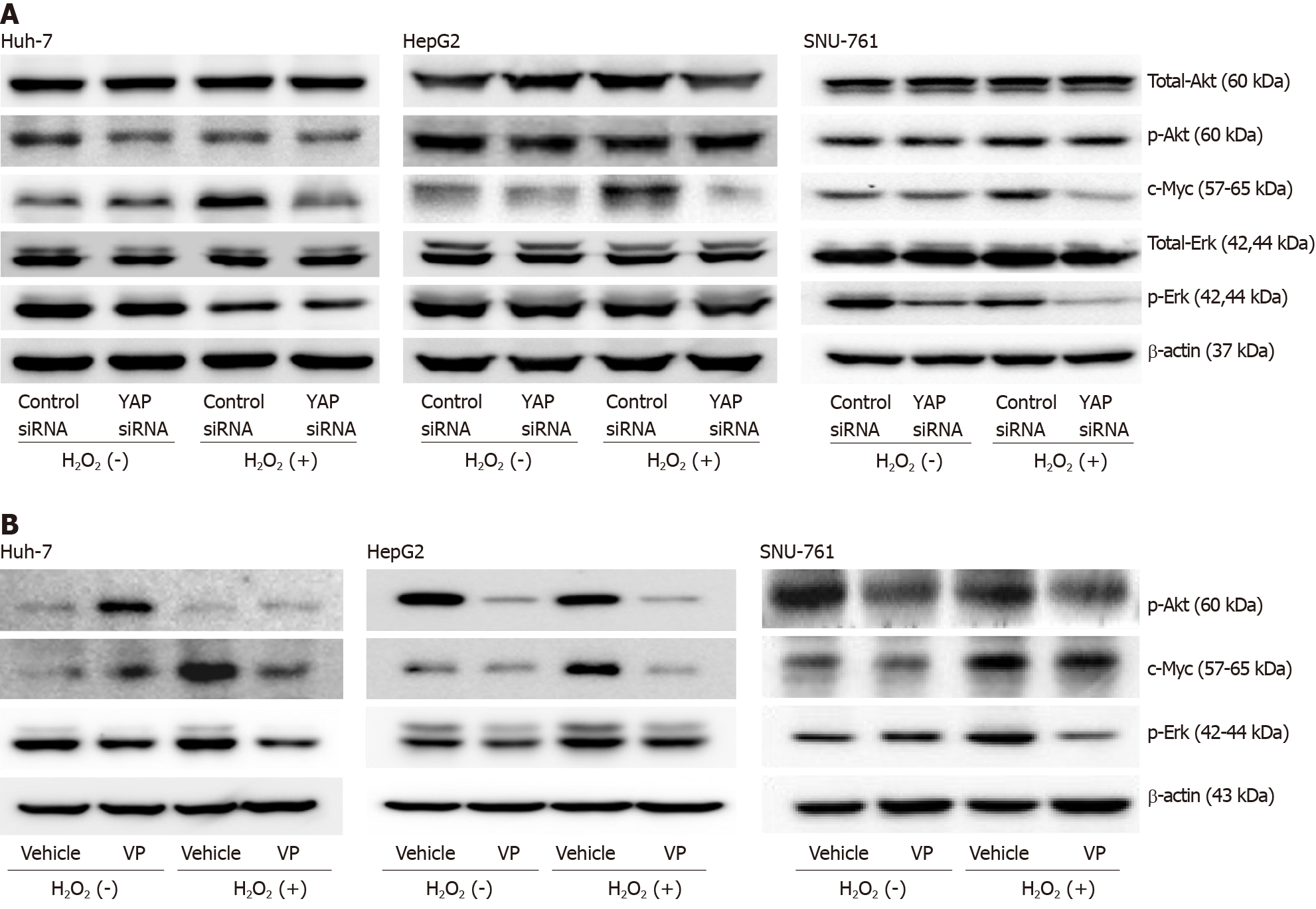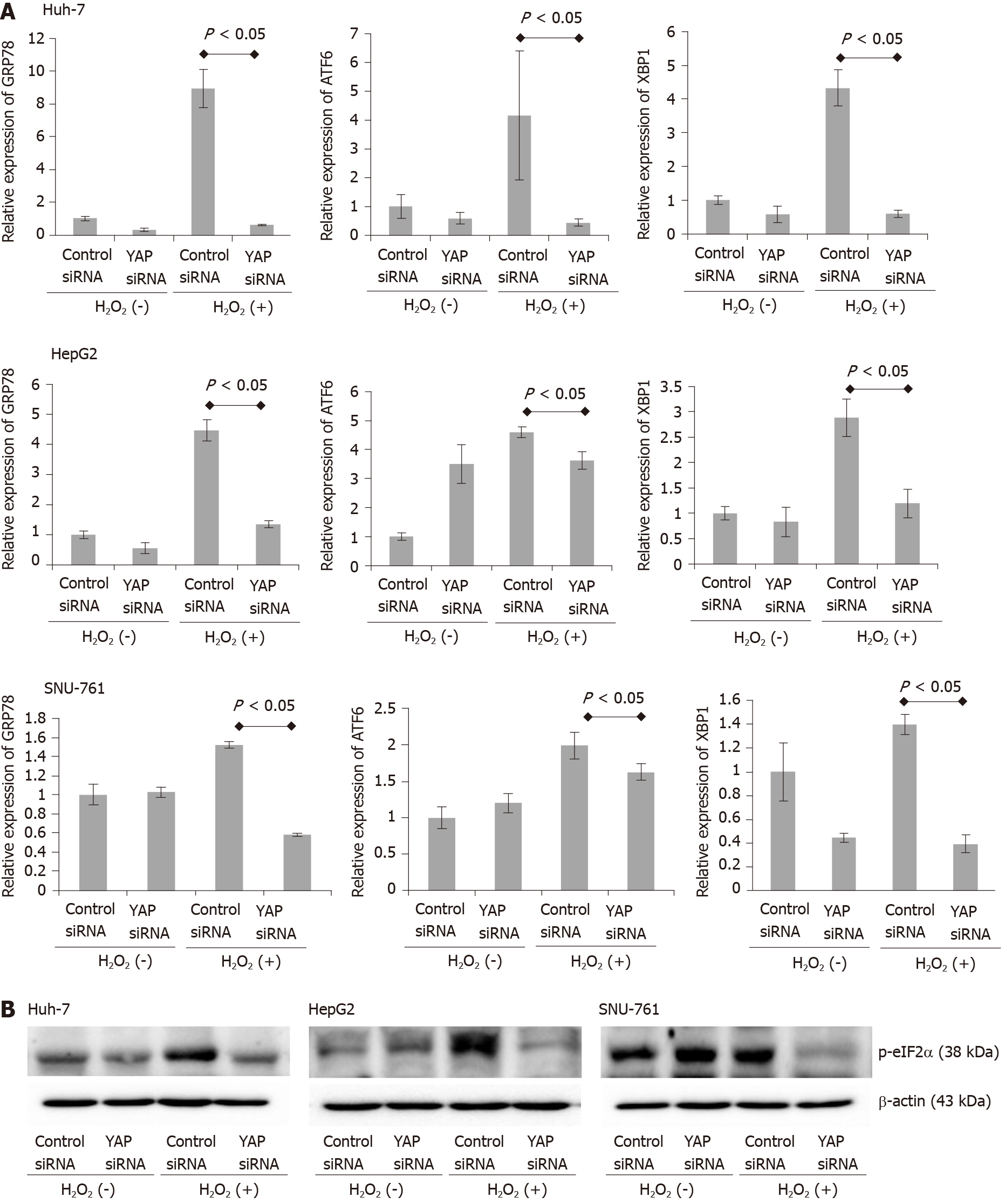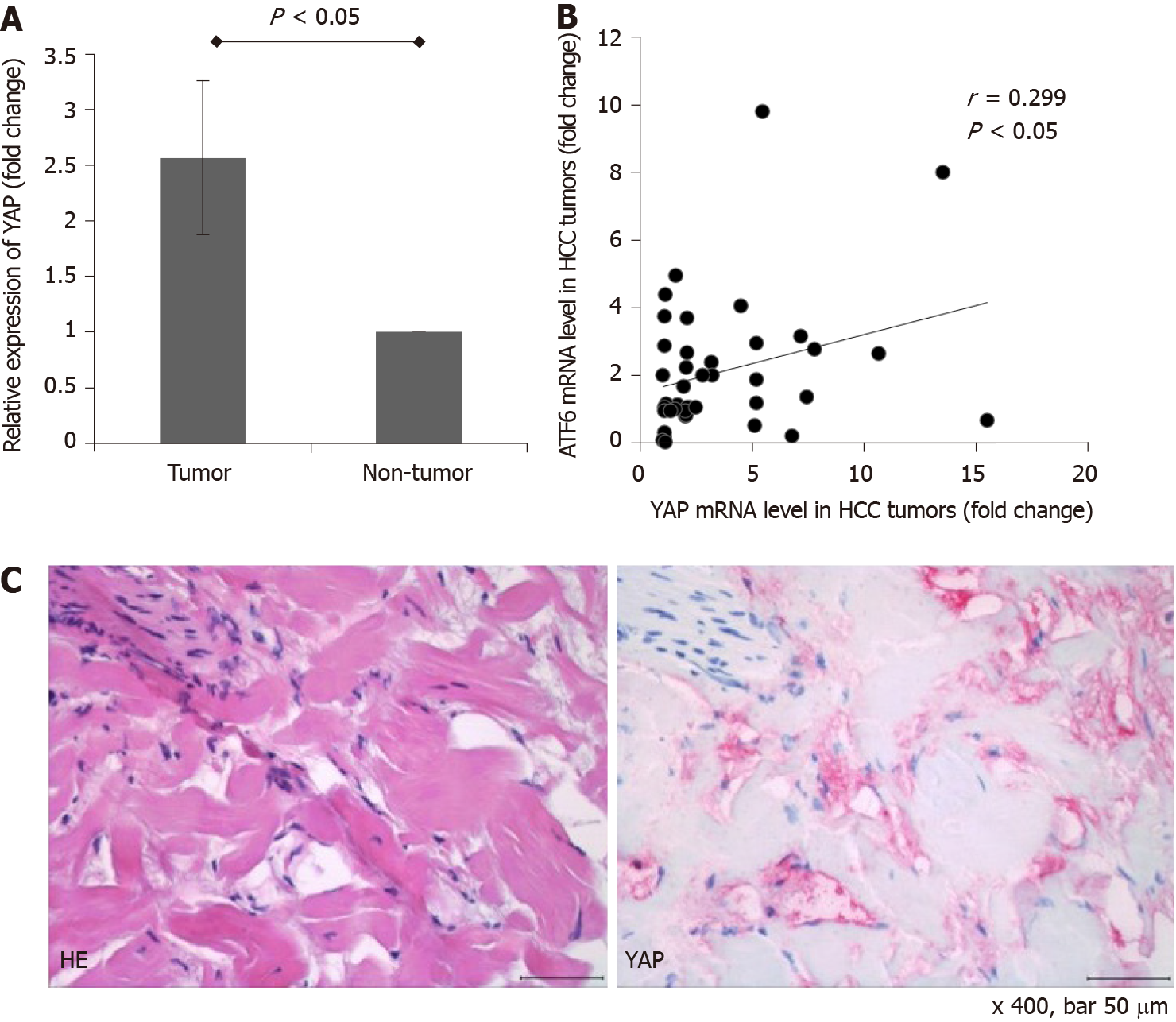Copyright
©The Author(s) 2020.
World J Gastroenterol. Nov 14, 2020; 26(42): 6599-6613
Published online Nov 14, 2020. doi: 10.3748/wjg.v26.i42.6599
Published online Nov 14, 2020. doi: 10.3748/wjg.v26.i42.6599
Figure 1 Reactive oxygen species enhanced the mRNA and protein expression of yes-associated protein-1 in hepatocellular carcinoma cells.
A: Yes-associated protein-1 (YAP-1) mRNA was significantly enhanced in hepatocellular carcinoma (HCC) cells treated with 150 μmol/L H2O2. YAP-1 mRNA expression was quantified using quantitative polymerase chain reaction and normalized to glyceraldehyde-3-phosphate dehydrogenase mRNA expression. The experiment was repeated three times. The data are expressed as the mean ± SD. The error bars represent the SD; B: The protein expression of YAP-1 in HCC cells was significantly enhanced when the HCC cells were exposed to 150 μmol/L H2O2, especially at 48 h. The experiment was repeated three times; C: Treatment with the antioxidant N-acetylcysteine inhibited the protein expression of YAP-1 in HCC cells. The experiment was repeated three times. YAP-1: Yes-associated protein-1; HCC: Hepatocellular carcinoma; SD: Standard deviation; NAC: N-acetylcysteine.
Figure 2 The effects of Yes-associated protein-1 on the proliferation of reactive oxygen species reactive oxygen species -exposed hepatocellular carcinoma cells.
A: An MTS assay was performed on hepatocellular carcinoma (HCC) cells that were treated with H2O2 (0-350 μmol/L), and the reactive oxygen species levels were increased by intervals of 50 μmol/L. The data are expressed as the mean ± SD of percent changes of optical densities. The experiment was repeated three times; B: Yes-associated protein-1 (YAP-1) small interfering RNA (siRNA) transfection significantly suppressed YAP-1 mRNA expression compared to control siRNA transfection in HCC cells (P < 0.05). The data are expressed as the mean ± SD. The experiment was repeated three times; C: When HCC cells were transfected with YAP-1 siRNA, the proliferation of HCC cells was significantly decreased compared with control siRNA transfection based on the MTS assay results (P < 0.05). The data are expressed as the mean ± SD of percent changes of optical densities. The experiment was repeated three times; D: When HCC cells were treated with verteporfin (1000 nmol/L), the proliferation of HCC cells was significantly decreased compared with the control treatment based on the MTS assay results (P < 0.05). The data are expressed as the mean ± SD of percent changes of optical densities. The experiment was repeated three times. YAP: Yes-associated protein; siRNA: Small interfering RNA; VP: Verteporfin.
Figure 3 Modulation of yes-associated protein-1 in reactive oxygen species-exposed hepatocellular carcinoma cells showed antitumor effects in an in vivo xenograft tumor mouse model.
A: H2O2 treatment significantly increased the proliferation of MH134 cells based on the MTS assay results (P < 0.05). The data are expressed as the mean ± SD. The experiment was repeated three times; B: Yes-associated protein-1 (YAP-1) small interfering RNA (siRNA) transfection significantly suppressed YAP-1 mRNA expression compared to control siRNA transfection in reactive oxygen species-exposed MH134 cells (P < 0.05). The data are expressed as the mean ± SD. The experiment was repeated three times; C: In the xenograft tumor model, the YAP-1 siRNA group showed significantly suppressed tumor growth compared to the control siRNA group at days 11, 12, and 13 after tumor budding (all aP < 0.05). The data are expressed as the mean ± SD. YAP: Yes-associated protein; siRNA: Small interfering RNA.
Figure 4 The oncogenic action of yes-associated protein-1 was activated by the c-Myc pathway in reactive oxygen species-exposed hepatocellular carcinoma cells.
A: Immunoblot analyses of phosphorylated-Akt, total-Akt, c-Myc, phosphorylated-p42/44 (Erk), total-p42/44 (Erk), and yes-associated protein-1 (YAP-1) were performed in reactive oxygen species (ROS)-exposed hepatocellular carcinoma (HCC) cells transfected with YAP-1 small interfering RNA (siRNA) or control siRNA. The experiment was repeated three times; B: Immunoblot analyses of phosphorylated-Akt, total-Akt, c-Myc, phosphorylated-p42/44 (p-Erk), total-p42/44 (Erk), and YAP-1 were performed in ROS-exposed HCC cells treated with verteporfin or control. The experiment was repeated three times. YAP: Yes-associated protein; siRNA: Small interfering RNA; VP: Verteporfin.
Figure 5 Up-regulation of the c-Myc pathway was dependent on yes-associated protein-1 expressions in reactive oxygen species-exposed hepatocellular carcinoma cells.
A: A c-Myc inhibitor (10058-F4, 60 μmol/L) significantly decreased the protein expression of yes-associated protein-1 (YAP-1) in reactive oxygen species (ROS)-exposed hepatocellular carcinoma (HCC) cells. The experiment was repeated three times; B: N-acetylcysteine treatment downregulated c-Myc protein expression in ROS-exposed HCC cell lines. The experiment was repeated three times; C: YAP-1 small interfering RNA (siRNA) transfection significantly suppressed c-Myc mRNA expression compared to control siRNA transfection in ROS-exposed HCC cells (all P < 0.05). The c-Myc mRNA expression was quantified using quantitative PCR and normalized to glyceraldehyde-3-phosphate dehydrogenase mRNA expression. The data are expressed as the mean ± SD. The experiment was repeated three times; D: Immunoblot analyses of c-Myc were performed in ROS-exposed HCC cells transfected with YAP-1 siRNA or control siRNA. The experiment was repeated three times. YAP: Yes-associated protein; siRNA: Small interfering RNA; NAC: N-acetylcysteine.
Figure 6 The reactive oxygen species-induced oncogenic action of yes-associated protein-1 in hepatocellular carcinoma cells led to an enhanced unfolded protein response.
A: Yes-associated protein-1 (YAP-1) small interfering RNA (siRNA) significantly decreased the mRNA expression of unfolded protein response markers, including 78-kDa (glucose-regulated protein 78/BiP), activating transcription factor-6, and XBP1, in reactive oxygen species (ROS)-exposed hepatocellular carcinoma (HCC) cells (P < 0.05). The experiment was repeated three times. The data are expressed as the mean ± SD; B: Immunoblot analyses of YAP-1 and phosphorylated-eIF-2α were performed in ROS-exposed HCC cells transfected with YAP-1 siRNA or control siRNA. The experiment was repeated three times. GRP78: Glucose-regulated protein 78; ATF-6: Activating transcription factor-6; YAP: Yes-associated protein; siRNA: Small interfering RNA.
Figure 7 Upregulated mRNA expression of yes-associated protein-1 was correlated with the expression of activating transcription factor-6 in human hepatocellular carcinoma tissues.
A: The mean mRNA expression of yes-associated protein-1 (YAP-1) was upregulated by 2.6-fold in hepatocellular carcinoma (HCC) tissues compared with nontumor tissues (n = 88). The data are expressed as the mean ± SD; B: The mRNA expression of YAP-1 was positively correlated with the mRNA expression of ATF6 (Pearson’s coefficient = 0.299; P < 0.05); C: The expression of YAP-1 in human HCC tissue was detected by immunohistochemistry (400 × magnification). Scale bars, 50 μm. YAP: Yes-associated protein; HCC: Hepatocellular carcinoma; SD: Standard deviation; ATF-6: Activating transcription factor-6; HE: Hematoxylin-eosin.
- Citation: Cho Y, Park MJ, Kim K, Kim SW, Kim W, Oh S, Lee JH. Reactive oxygen species-induced activation of Yes-associated protein-1 through the c-Myc pathway is a therapeutic target in hepatocellular carcinoma. World J Gastroenterol 2020; 26(42): 6599-6613
- URL: https://www.wjgnet.com/1007-9327/full/v26/i42/6599.htm
- DOI: https://dx.doi.org/10.3748/wjg.v26.i42.6599









